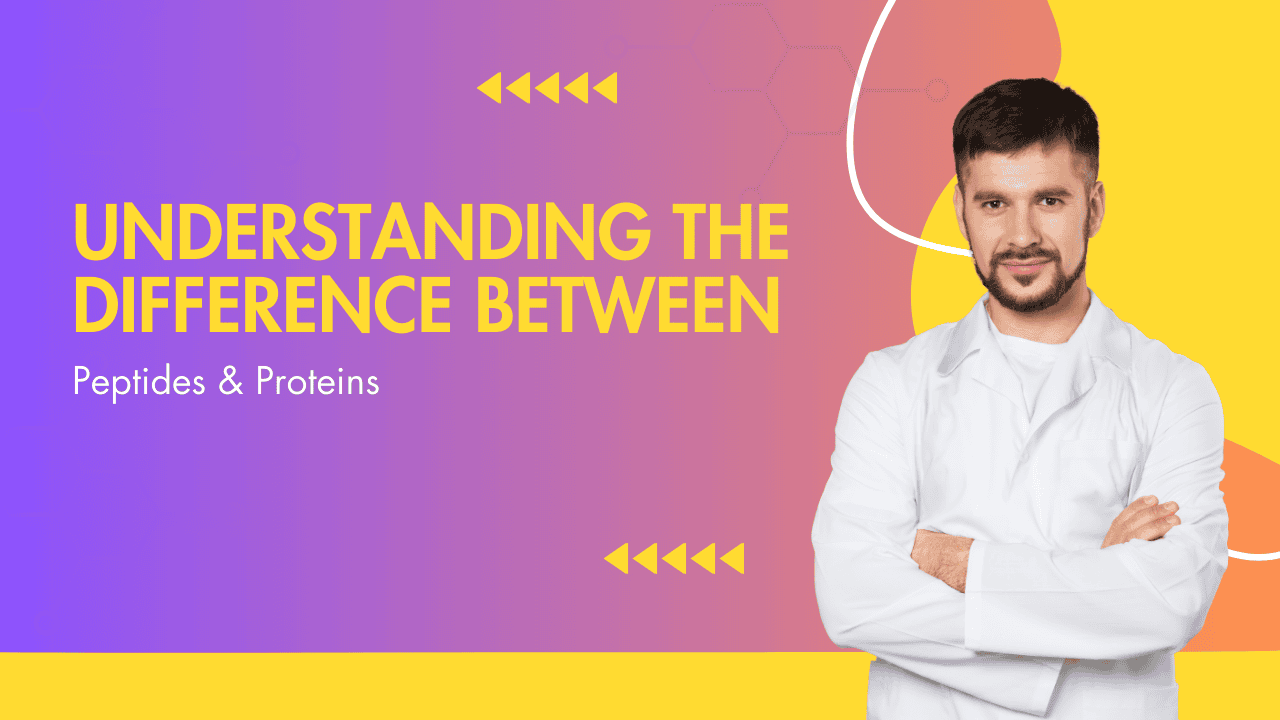

Peptide synthesis is transforming life science research by providing tailored solutions for myriad scientific queries.
With advancements in custom peptide synthesis, researchers are now equipped to develop synthetic peptides that can mimic natural processes, paving the way for groundbreaking discoveries.
This article delves into the world of peptides, shedding light on why this topic is a game-changer in life sciences, and why diving into the details is worth every bit of your time.
Peptides, essentially short chains of amino acids, are fundamental to numerous biological functions. Think of them as the words formed by the letters of the amino acid alphabet. They might be short in length, but their impact on cellular processes is huge!
While both peptides and proteins are chains of amino acids, peptides are generally shorter, typically less than 50 amino acids. If proteins are novels, peptides are more like short stories—compact yet powerful.
Peptides serve as hormones, neurotransmitters, and growth factors. They’re vital in understanding diseases, developing new drugs, and creating diagnostic tools. For researchers, they’re like the Swiss Army knives of the biochemical world.
Peptide synthesis refers to the laboratory techniques used to assemble amino acids into peptides. Imagine piecing together a jigsaw puzzle where each piece is an amino acid, and you’re crafting a complete picture—a functional peptide.
In peptide synthesis, amino acids are sequentially bonded using peptide bonds. This meticulous process can be compared to stringing beads to form a necklace, with each bead representing an amino acid.
The two primary methods for peptide synthesis are solid-phase peptide synthesis (SPPS) and liquid-phase peptide synthesis. SPPS is akin to building a sculpture from a solid block, while liquid-phase synthesis is more like dissolving ingredients to create a solution.
From drug development to vaccine creation, peptide synthesis touches many fields. Imagine a key (the peptide) fitting perfectly into a lock (a biological target), unlocking potential treatments and diagnostic tools.
Peptide synthesis isn’t always smooth sailing. Issues like side reactions and the need for specific protecting groups can make the journey bumpy. But overcoming these obstacles is part of the adventure, leading to remarkable scientific achievements.
Custom peptide synthesis delivers tailored peptides designed to meet specific research needs. Think of it like ordering a bespoke suit—a perfect fit for your scientific requirements.
Selecting a custom peptide synthesis service involves evaluating factors like purity, length of the peptide chain, and delivery time. It’s like choosing a caterer for your event—you want reliability and quality on your special day.
Custom peptide synthesis allows researchers to design peptides with specific sequences and modifications. This bespoke approach can be compared to commissioning a piece of art, where every detail matters.
Despite its advantages, custom peptide synthesis can be costly and time-consuming. Imagine commissioning a hand-crafted statue—high-quality, but not always quick or cheap.
A synthetic peptide is a lab-made chain of amino acids. Unlike their natural counterparts, they’re crafted in the lab—a bit like 3D printing, but for bioactive molecules.
Synthetic peptides are invaluable for studying protein interactions, developing drugs, and creating vaccines. They’re like tiny research assistants, helping unlock the secrets of biological processes.
While natural peptides are produced by living organisms, synthetic peptides are lab-built. It’s much like comparing organic produce to genetically modified crops—each has its own advantages and applications.
Crafting synthetic peptides involves assembling amino acids in a specific order. This precise process is akin to constructing a detailed model, where every piece must fit perfectly.
In peptide synthesis, a reagent is a substance used to cause a chemical reaction. They’re like the catalysts in our kitchen recipes, essential for a successful outcome.
Reagents such as coupling agents and deprotecting agents play crucial roles. Imagine them as specialized tools in a craftsman’s workshop, each with a distinct purpose.
Choosing the right reagent depends on factors like the type of peptide and desired purity. It’s much like selecting the right sports equipment—you need the right tool for optimum performance.
Reagents are pivotal in ensuring peptide purity. They’re like quality control inspectors, ensuring the final product meets the required standards.
Solid phase peptide synthesis (SPPS) is a technique where peptides are synthesized on a solid support. Think of it like building a skyscraper, with each amino acid as a brick added one at a time on a solid foundation.
SPPS involves attaching the first amino acid to a resin and then sequentially adding the remaining amino acids. It’s like constructing a layered structure, ensuring each piece is perfectly aligned.
SPPS offers high efficiency, automation, and ease of purification. It’s like having a high-tech machine that speeds up production and ensures quality.
Compared to liquid phase synthesis, SPPS is faster and more versatile. Imagine the difference between hand-stitching a quilt and using a sewing machine—both effective, but one is far quicker.
Solid-phase synthesis refers to any chemical process performed on a solid support. It’s like working on a stable platform, allowing for precision and control in the synthesis process.
The steps include attaching reactants to the solid phase, performing the reaction, and then detaching the final product. It’s a methodical process, akin to assembling a complex puzzle.
Solid-phase synthesis is used in peptide and DNA synthesis, as well as drug discovery. It’s like a versatile tool in a scientist’s toolkit, adaptable to various tasks.
Challenges like incomplete reactions and difficulty with large molecules can arise. But like any problem, solutions such as optimizing reagents and conditions exist to overcome these hurdles.
To synthesize peptides efficiently, strategies like using automated peptide synthesizers and optimized coupling methods are essential. It’s all about using the right approach for the best outcome.
Costs can vary depending on the peptide complexity, length, and purity requirements. It’s like budgeting for a project—the more intricate, the higher the cost.
Optimization involves fine-tuning reaction conditions, reagents, and protecting groups. Think of it as tweaking a recipe to get that perfect dish every time.
Advances like high-throughput peptide synthesis and convergent synthesis are revolutionizing the field. It’s akin to upgrading from a manual typewriter to a high-speed computer.
In peptide synthesis, the solid phase is the support on which peptide chains are assembled. It’s like the canvas for a painter, providing a stable base to create the masterpiece.
The solid phase allows for easy separation of the peptide product from the reaction mixture. Imagine being able to lift your painting from the canvas effortlessly when it’s done.
Techniques include various types of resins and linking strategies. It’s like choosing the right canvas and brush to achieve the desired artistic effect.
Issues like resin swelling and incomplete reactions can occur. Solutions include optimizing conditions and using specialized resins, much like finding the right materials for a complex sculpture.
A coupling reagent facilitates the formation of peptide bonds between amino acids. Think of it as the glue in your model kit, holding pieces together firmly.
Common types include carbodiimides and phosphonium salts. Each serves a unique purpose, like different adhesives for various surfaces.
The choice depends on factors such as the specific peptide and desired reaction efficiency. It’s like selecting the best adhesive for a particular repair job—one size does not fit all.
Coupling reagents significantly impact the yield and purity of the synthesized peptides. They’re like the secret ingredients in a recipe, critical for the final flavor.
Peptide synthesis is the process of creating short amino acid chains, while protein synthesis involves forming longer chains. It’s like building smaller Lego sets (peptides) before moving on to massive structures (proteins).
Differences include the length of the amino acid chain and the complexity of the synthesis process. Peptide synthesis is simpler and more straightforward, while protein synthesis is more intricate.
Advanced techniques include ribosome display and cell-free protein synthesis. These methods are like high-tech tools that bring efficiency and precision to protein assembly.
Peptides serve as models and tools in studying protein synthesis. They’re like the test pieces that help perfect the techniques for building larger protein structures.
Peptide synthesis is crucial in creating peptide-based drugs for diseases like cancer and diabetes. It’s like crafting keys to unlock new treatments for these conditions.
Peptides are used in diagnostic assays to detect diseases accurately. Think of them as diagnostic detectives, gathering clues to reveal the underlying condition.
Peptide vaccines are designed to stimulate immune responses. They’re like training programs for the immune system, preparing it to combat real threats.
Peptides help identify and study biomarkers for various diseases. They act as indicators, pointing researchers in the right direction for disease detection.
Recent advancements include automated peptide synthesizers and novel coupling reagents. These technologies are like upgrading from a horse-drawn carriage to a sports car.
Technology has made peptide synthesis faster, more efficient, and more accessible. It’s akin to the impact of smartphones in our daily lives—revolutionary and indispensable.
Future trends include more precise synthesis methods and hybrid technologies. It’s an exciting frontier, promising even more breakthroughs and innovations.
Efficiency can be boosted by optimizing conditions and using high-quality reagents. It’s like tweaking the engine of a car for better performance.
Pitfalls include incomplete reactions and side reactions. Solutions involve fine-tuning reaction parameters and using protective groups strategically.
Automation in peptide synthesis allows for high-throughput synthesis and reduced human error. It’s like moving from handcrafting to mass production while maintaining quality.
Analytical techniques ensure the purity and quality of synthesized peptides. They are the quality control measures, ensuring the product meets high standards.
Techniques include mass spectrometry and high-performance liquid chromatography. These methods are like forensic tools, analyzing and confirming the peptide structure.
Purity is assessed using chromatographic techniques, ensuring that the final product is free from impurities. It’s akin to sifting through sand for valuable nuggets.
Quantification involves measuring the amount of synthesized peptide using techniques like UV spectroscopy. It’s like weighing ingredients to ensure the right proportions in a recipe.
Costs vary based on factors like peptide length and complexity. It’s like planning a construction project—the more elaborate the design, the higher the cost.
Balancing cost and quality involves choosing reliable suppliers and optimizing synthesis conditions. It’s like finding the best value-for-money products without compromising quality.
Advanced technologies can reduce overall costs through efficiency and automation. It’s like installing solar panels—initially costly but economically beneficial in the long run.
Success stories include peptide drugs like insulin and diagnostic tools for detecting HIV. These cases are like triumphant tales, showcasing the power and potential of peptide synthesis.
Failures often teach valuable lessons in optimizing conditions and selecting reagents. They’re the cautionary tales that guide future successes.
Innovative research includes designing peptides for neurodegenerative diseases and cancer. These projects are the cutting-edge experiments, pushing the boundaries of what’s possible.
Ethical issues include the use of animal models and potential misuse in bioterrorism. It’s like walking a tightrope, balancing scientific advancement with ethical responsibility.
Regulatory guidelines ensure safe and ethical synthesis practices. They’re the rulebooks that scientists must follow to ensure responsible research.
Responsible use involves transparency, proper documentation, and ethical standards. It’s akin to operating in a lighthouse, maintaining visibility and integrity at all times.
Peptide synthesis continues to expand the frontiers of biochemistry, driving innovations and uncovering new horizons in medical research and therapeutic development.
Peptide synthesis typically involves several steps:
The process of peptide production involves:
Peptides can be relatively easy to synthesize using automated synthesizers; however, complexity increases with peptide length and specific amino acid sequences. Issues like side reactions, incomplete coupling, and proper protection of side chains can make certain peptides challenging to produce.
Polypeptides are synthesized through:
Peptide synthesis involves:
The formation of a peptide bond includes:
Naming peptides follows these steps:
Stages in the formation of peptide links include:
Making a peptide involves:
Your body produces peptides through:
Dr. Philip E. Dawson is a distinguished researcher in the field of peptide chemistry and biochemistry, with over 25 years of experience. He is a prominent figure at The Scripps Research Institute, where his work has significantly advanced the understanding and application of peptide synthesis, particularly in solid-phase peptide synthesis (SPPS) and native chemical ligation. Dr. Dawson’s pioneering contributions have been crucial in the synthesis of complex peptides and proteins, impacting therapeutic developments and biotechnological applications.
Dr. Dawson’s notable publications include:
Dr. Dawson has received numerous accolades, including the Vincent du Vigneaud Award from the American Peptide Society, underscoring his authority and trustworthiness in peptide chemistry and synthesis.
Dr. Lei Wang is a renowned expert in the field of therapeutic peptides, focusing on peptide drug discovery and development. Currently at the University of California, San Francisco, Dr. Wang has more than 15 years of experience and has made significant contributions to understanding and applying peptides in medicine. His research has been pivotal in advancing peptide therapeutics, particularly for cancer and infectious diseases, and his innovative methods have been widely adopted in peptide synthesis research.
Dr. Wang’s notable publications include:
Dr. Wang’s innovative approach and rigorous methodology have earned him recognition, including the MilliporeSigma Life Science Award, highlighting his expertise and the impact of his research on peptide synthesis and therapeutic development.
Białkowska, A. M., Morawski, K., & Florczak, T. (2017). Extremophilic proteases as novel and efficient tools in short peptide synthesis. Journal of Industrial Microbiology & Biotechnology, 44(9), 1325–1342. https://doi.org/10.1007/s10295-017-1961-9
Liu, T., Peng, Z., Lai, M., Hu, L., & Zhao, J. (2024). Inverse peptide synthesis using transient protected amino acids. Journal of the American Chemical Society, 146(6), 4270–4280. https://doi.org/10.1021/jacs.4c00314
Marahiel, M. A. (1992). Multidomain enzymes involved in peptide synthesis. FEBS Letters, 307(1), 40–43. https://doi.org/10.1016/0014-5793(92)80898-q
Muchowska, K. B., & Moran, J. (2020). Peptide synthesis at the origin of life. Science, 370(6518), 767–768. https://doi.org/10.1126/science.abf1698
Süssmuth, R. D., & Mainz, A. (2017). Nonribosomal Peptide Synthesis—Principles and Prospects. Angewandte Chemie International Edition, 56(14), 3770–3821. https://doi.org/10.1002/anie.201609079
Svensen, N., Peersen, O. B., & Jaffrey, S. R. (2016). Peptide synthesis on a Next‐Generation DNA Sequencing platform. ChemBioChem, 17(17), 1628–1635. https://doi.org/10.1002/cbic.201600298
Vaida, V., & Deal, A. M. (2022). Peptide synthesis in aqueous microdroplets. Proceedings of the National Academy of Sciences, 119(44). https://doi.org/10.1073/pnas.2216015119
ALL ARTICLES AND PRODUCT INFORMATION PROVIDED ON THIS WEBSITE ARE FOR INFORMATIONAL AND EDUCATIONAL PURPOSES ONLY. The products offered on this website are intended solely for research and laboratory use. These products are not intended for human or animal consumption. They are not medicines or drugs and have not been evaluated or approved by the FDA to diagnose, treat, cure, or prevent any disease or medical condition. Any form of bodily introduction is strictly prohibited by law.




Discount Applied Successfully!
Your savings have been added to the cart.